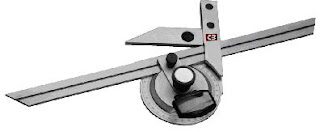To get familiar with the use of bevel protractor, vernier protractor & clinometer for measuring angles.
Apparatus
- Plain bevel protractor.
- Vernier protractor
- Clinometer
- A metallic triangular specimen
Plain bevel protractor:
When two surfaces are at any angle other than 90o, the angle between them must be tested with some form of protractor. Instruments for this purpose may have a scale of degrees, enabling the angle to be read off, or they may consist of gauge which must be set to the angle before use. And the bevel protractor in fig. 1 is an example of this second variety of gauges, & must be set to the correct angle before use.

Vernier Protractor:
The main scale of this device is divided up into degrees from 0o to 90o each way. The vernier scale is divided up to that 12 of its division occupying the same space as 23o on the main scale, thus 1 vernier division = 23/12 = 1.92 degree on main scale. The instrument therefore allows settings to 5 min of angle to be obtained, so we use it to get accurate readings. This device has a movable arm, plate blade, fixed nut & vernier scale, see fig. 2.

The Clinometer:
The clinometer is a special case of the application of the spirit level. In this instance the level is mounted in a ratable body carried in a housing, one face of which forms the base of the instrument. A main use of the instrument is the measurement of the included angle of two adjacent faces of a work piece. Thus, in use, the instrument base is placed on one face and the rotating table body is adjusted until a zero reading of the bubble is obtained. The angle of rotation necessary to bring this about is then shown on an angular scale moving against an index.
A second reading is taken in a similar manner in the second face of the work piece, the included angle between the faces being the difference the first & the second readings. Depending upon the type of instrument used, readings direct to 1 min are obtained, & up to a range of movement of 90o, see fig. 3.
Main scale = 360o.
Vernier scale: Full revolution = 1o = 60 min, so each division on vernier scale = 1 min.

Procedure
First of all we clean the component & remove the burrs if there are any, also make sure that the surface plate is nice & clean. In order to avoid compound angle error care must be taken in aligning the work piece with the measuring tool.
Then we take the readings of angles 1, 2 & 3 on the specimen using each of the provided equipment then fill the results in table 1.

Discussion
The personal skills needed for taking angular measurements are to know exactly how to fit the desired angle on the specimen on the measuring device & holding it still, an additional skill is needed when using the vernier protractor which is to know how to take the reading precisely.
The overall time needed to take the readings depends on the personal skills of the one taking the reading.

No comments:
Post a Comment